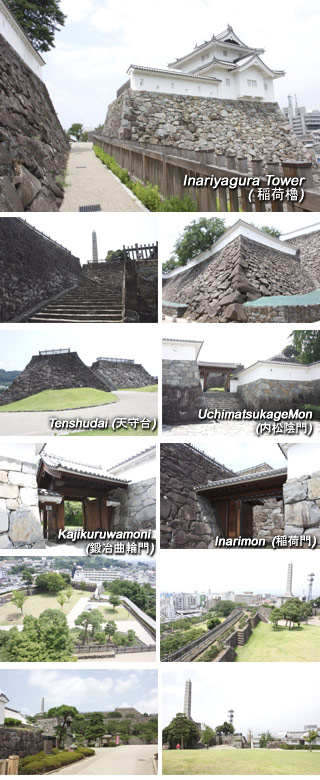Check out the greatest stone wall of Kofu Castle. All of them are built with natural rocks and preserved from the original shape. When you see this castle from out side, you will understand how hard to attack this castle against such a great tall stone walls with moat. The layers of stone walls are not just many but also high as well. The view from the base of the Tenshu, you can see great view of Kofu City and beautiful mountains of Yamanashi. Also, when you look down closely, you can see the shape of Kofu Castle how it's used be.
There is no Tenshukaku, main keep tower, but everything else is well preserved, especially, stone walls are beautiful.
History
After the Takeda Family succumbed. Kai province became the fief of Nobnaga Oda. When Nobunaga passed away it came under the governance of Ieyasu Tokugawa.
When Hideyoshi Toyotomi unified the country, he ordered for the castle to be built. It was later complete by Nagamasa Asano and his son. After the Battle of Sekigahara, Kofu Castle fell into the hands of the Tokugawa Family to whom it belonged until the end of the Tokugawa Shogunate.
In the early Edo Era, Tsunatoyo Tokugawa became the heir of the fifth Shogun, and moved to Edo Castle. Yoshiyasu Yanagisawa then became the Lord of Kofu Castle. Under his command the castle was fully repaired and the castle's town was also developed. However, Yanagisawa was transferred and became under the control of a retainer stationed in Kofu. Also during this period Honmaru Palace and Akaganemon gate were destroyed by a large fire.
Later in the Meiji Era the castle was abandoned and in around 1877, major buildings in the castle were destroyed. Thereafter the castle area was used as an industrial testing facility. In 1897 it was decided the Yakatakuruwa and Shimizukurawa Enclosures should be dismantled to make way for Kofu Station.
In 1904 the area around the Honmaru was opened to the public as Maizuru Park and in 1930 the Government Offices and Assembly Hall moved to the dismantled lot of the western and southern moats were completely buried, and the appearance of the castle ruins became almost the same as they are seen today.
Inari Yagura
The shape and structure of the Inari Yagura were developed based on old drawings, documents and pictures together with information collated from excavations. It was built in an attempt to replicate the original building constructed in 1664. This tower was built in the early Edo era and was used as a storage unit for weapons. It survived until the early Meiji era.
This stone wall, approximately 17m high, was a leader in technique at the time of its construction and is comprised of all natural rocks. The castle's stone wall, built in the 16th century is one of the tallest in the country.






